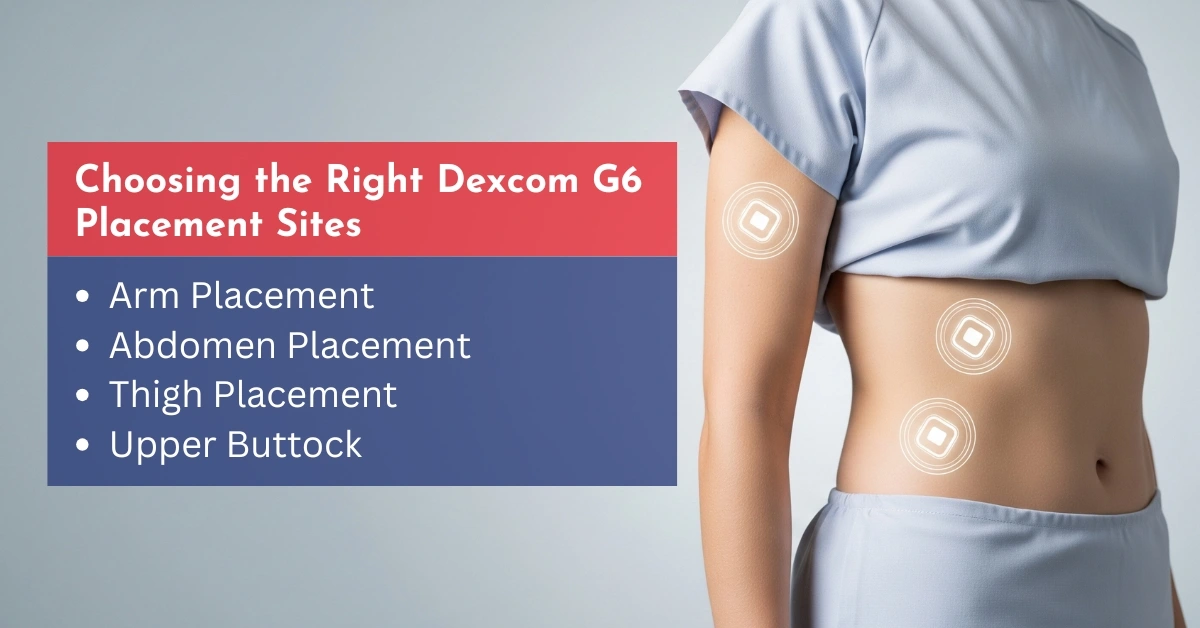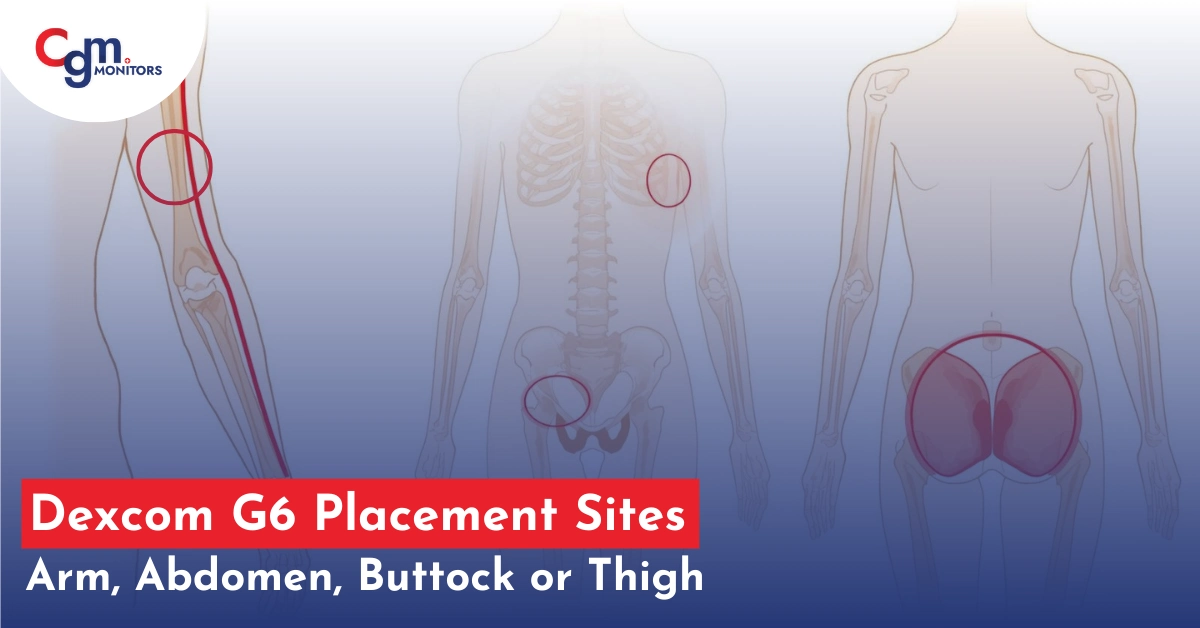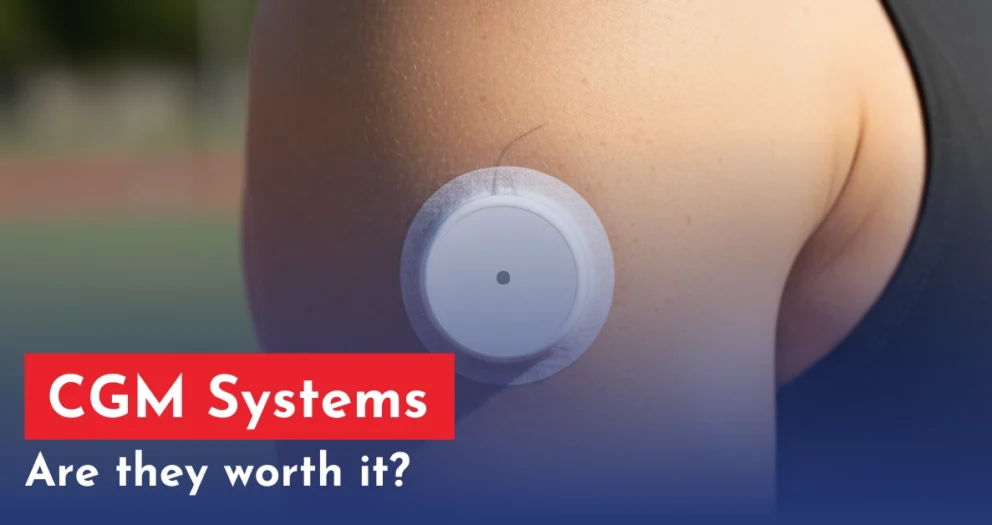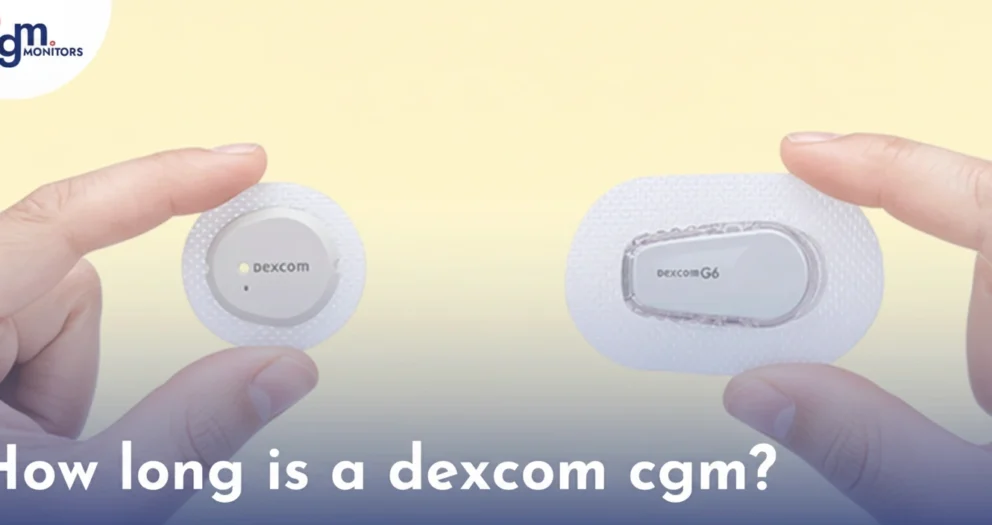Table of content
- Introduction
- Dexcom G6 Sensor Placement Fundamentals
- Choosing the Right Dexcom G6 Placement Sites: FDA-Approved
- Where Not to Place Your Sensor
- Factors Affecting Sensor Placement Choice (G6/G7)
- Best Practices for Dexcom G6 Placement Success
- Dexcom G6 Insertion Site Bleeding
- Buy Dexcom G7, a Better CGM option
- Conclusion
Introduction
Are you interested in knowing the perfect Dexcom G6 placement sites? You have landed on the right article because many Cgm monitors’ patients ask about it. Here we have discussed the most appropriate insertion sites for Dexcom G6. The Dexcom G6 is a continuous glucose monitoring (CGM) system that provides accurate and reliable glucose readings to help people with their effective diabetes self-management.
With its small size and comfortable design, the Dexcom G6 has become popular among people with diabetes who want to track their glucose levels more conveniently and without frequent fingerstick tests. One of the essential factors in achieving accurate and reliable glucose readings with the Dexcom G6 is choosing the right placement site for the device.
In this article, we will explore the different placement sites available for the Dexcom G6 and provide tips for ensuring accuracy and comfort with proper Dexcom locations on body.
Dexcom G6 Sensor Placement Fundamentals
The Dexcom G6 sensor uses a thin filament that sits just beneath your skin in the interstitial fluid. This Dexcom sensor measures glucose levels continuously throughout the day and night for up to 10 days. Unlike insulin pumps like Tandem mobi or TSlim x2 that deliver medication, the CGM sensor only monitors.
Proper insertion site selection ensures the sensor filament remains in optimal position within the subcutaneous tissue. It provides reliable data without interference from muscle movement or inadequate tissue depth. The goal is to find areas with sufficient fatty tissue while avoiding regions prone to sensor compression or friction.
Choosing the Right Dexcom G6 Placement Sites: FDA-Approved
The Dexcom G6 can be placed in several different locations on the body, including the arm, abdomen, thigh, and lower back. Each placement site has its pros and cons, so it’s essential to consider each option carefully before deciding.
- Back of the Upper Arm
- Abdomen
- Upper Buttocks
- Thigh or Leg Placement
Back of the Upper Arm (Popular Off-Label Location)
The arm is a popular placement site for the Dexcom G6 due to its ease of use and comfortable design. Diabetic patients mainly apply this device to the back of their arms. It is also a good alternative to the abdomen, especially since it is less prone to movement and can stay on better for some users. However, there are some factors to consider keeping the arm site free from scars or irritation, avoiding areas that are frequently bumped, and rotating placements to allow the skin to heal.
Abdomen Placement Site (Primary Approved Site)
The abdomen is a recommended site for placing the Dexcom G6 sensor. Precisely, the instructions for use recommend placing the sensor on the lower abdomen, about 2 inches (5 cm) away from the belly button. This area is chosen because it has a good blood supply and is relatively free from muscle tissue, which can interfere with the accuracy of the sensor readings.
Upper Buttock (Alternative Sensor Site)
An approved site for children and adolescents aged 2-17. This area is recommended because it provides sufficient subcutaneous tissue for better sensor insertion, reduces the risk of accidental bumps or dislodgement during daily activities, and is generally comfortable for long-term wear. Care should be taken to rotate sites within the upper buttocks region to prevent skin irritation or tissue overuse
Dexcom G6 Thigh Placement
Some people are curious to know where to put the Dexcom G6 on the leg and thigh. The thigh is a popular alternative site for CGM insertion. It is a large, flat surface with a thick subcutaneous fat layer, allowing easy insertion and accurate readings. Moreover, the site only comes into contact with the environment occasionally.
Considerations:
- Choose the front or upper outer thigh to avoid muscles that flex frequently.
- Ensure the area is flat, stable, and free from clothing friction.
- Rotate sites to prevent irritation or tissue overuse.

Where Not to Place Your Sensor
To keep your device comfortable, reliable, and kind to your skin, avoid the following areas:
- Over Bones: Skip spots like ribs, hipbones, or any bony edges. The sensor won’t sit well there and may feel uncomfortable, and also show accuracy problems.
- Irritated Skin: Redness, rashes, cuts, or any ongoing skin issue—don’t place your sensor at these areas. Let your skin heal first, then apply.
- Scars and Tattoos: Avoid inserting over old scars or inked skin. Both can affect how well the G6 sensor works and may cause extra irritation.
- Close to Other Devices: Keep at least 3 inches (about a finger’s width or more) away from insulin pump sites or regular injection spots to reduce interference.
Factors Affecting Sensor Placement Choice (G6/G7)
Lifestyle Considerations
Your daily activities should influence where you place your sensor:
- Athletes: Consider placement that won’t interfere with your sport. If you are a football player, choose the back of the arm because it has easy access, good accuracy, less clothing rub, and stays secure with arm bands during running.
- Manual laborers: Avoid areas prone to bumps or pressure. It may cause your sensor to fall off or give inaccurate readings.
- Parents of young children: Choose sites less likely to be grabbed.
- Fashion preferences: Select locations easily hidden by your wardrobe.
Body Composition
Your body type affects optimal placement:
- Leaner individuals: May find the abdomen or upper buttocks more comfortable.
- Larger body types: Often have more placement options.
- Muscular builds: Should target areas with more subcutaneous fat rather than muscle.
Sleeping Habits
Consider your sleep position when choosing a placement site:
- Stomach sleepers: Upper arm or upper buttocks work well.
- Side sleepers: Alternate sides or use the upper buttocks.
- Back sleepers: Abdomen or the upper arm is typically comfortable in this situation.
Best Practices for Dexcom G6 Placement Success
Follow these expert-recommended practices to maximize your sensor performance and comfort.
- Clean and dry skin thoroughly; use rubbing alcohol before application.
- Rotate sites to avoid overuse and maintain healthy skin.
- Avoid moles, scars, stretch marks, or irritated/damaged skin.
- Let sensors reach room temperature before applying.
- Press firmly around patch edges for 30 seconds.
- Protect sensor from water; use waterproof covers if needed.
- Check sites regularly for infection, redness, or scarring.
- Track experiences to optimize personal site rotation.
Dexcom G6 Insertion Site Bleeding
One potential issue with inserting the Dexcom G6 insertion site is bleeding, which is mostly reported by our CGM Monitors’ users. This can occur for various reasons, such as the depth of the insertion or the skin’s sensitivity. Bleeding can also occur if the sensor is inserted into a blood vessel or if the Dexcom G6 placement sites are not properly cleaned before insertion.
Bleeding at the insertion site can be concerning for some people also reported by Dexcom officially. This is because it can impact the accuracy of the glucose readings and may also be uncomfortable or painful. Following proper insertion techniques and monitoring the insertion site after insertion is essential to ensure that bleeding does not occur.
If bleeding is noted, applying pressure to the site and monitoring it closely for any signs of infection or other complications is recommended. It’s also important to contact a healthcare provider if bleeding is excessive or if there are other concerns related to the insertion site.
Buy Dexcom G7, a Better CGM option
Dexcom G6 is an exceptional CGM system. However, it comes with some drawbacks that the users must pay attention to. Considering this fact, you can buy Dexcom G7 online to get your blood glucose levels checked by a reliable firm. The insertion sites of this device are similar to Dexcom G6 placement sites.
However, this innovative device comes with numerous advanced features. You can buy other high-quality CGMs from cgmmonitors.com at a reasonable price. We are famous for providing the best quality CGM systems to treat your diabetes better. Our primary objective is to satisfy our customers with our best.
If you have purchased the G7 and want to know the recommended Dexcom G7 placement areas, here’s a complete guide. It will surely help in the correct placement.
Conclusion
The Dexcom G6 is a popular and effective CGM system that can help people with diabetes manage their condition more effectively. Choosing suitable Dexcom G6 placement sites is essential for achieving accurate and reliable glucose readings. Several options are available, including the arm, abdomen, thigh, and lower back.
Each placement site has pros and cons, and it’s essential to consider individual preferences and needs when choosing a location. Athletes may have different considerations when choosing a placement site. Bleeding at the insertion site is a potential issue that should be monitored closely.
By following proper insertion techniques and watching the insertion site, people with diabetes can achieve better glucose management.
Faqs
What is Dexcom G6?
A continuous glucose monitoring system that helps manage diabetes by providing accurate and reliable glucose readings.
Where is the most accurate place to put a Dexcom G6?
The back of the upper arm is generally the most accurate for adults, while the abdomen can also be used for adults or teens. Accuracy depends on avoiding tight clothing and muscle pressure.
Can I put a Dexcom G6 on my thigh?
Thigh placement is off-label and not recommended due to lower accuracy and potential compression issues.
Can you put a Dexcom G7 on your chest?
No it is not. Chest placement is not officially recommended and may affect accuracy or sensor longevity.
What are the different placement sites for Dexcom G6?
Arm, abdomen, thigh, and lower back are the recommended placement sites for Dexcom G6.
Can the Dexcom G6 go on ARM?
Yes, the back of the upper arm is the recommended site for adults for best accuracy.
Can the Dexcom G6 go on ARM?
Yes, the back of the upper arm is the recommended site for adults for best accuracy.
Where can I put my Dexcom besides my stomach?
You can stick it on the back of your upper arm for easy access during the day, or try the upper buttocks if you’re a kid under 18. Adults can use off-label spots like thigh or chest—consult your doctor first.
Can a Dexcom G6 be worn on the back of the arm?
Yes, this is the preferred site for adults and generally provides the most accurate readings.
Where is the recommended site for placing the Dexcom G6 sensor?
The lower abdomen, about 2 inches away from the belly button, is the recommended site for placing the Dexcom G6 sensor.
Can I go through airport security with my Dexcom G6?
Yes, you can carry it and notify TSA if needed. CGMs are allowed as medical devices.
What are the best Dexcom G6 placement sites for athletes?
The upper arm, abdomen, thigh, and lower back are suitable placement sites for athletes depending on their sports activities and preferences.
Is Dexcom better on arm or stomach?
Clinical data indicate comparable accuracy between the arm and abdomen sites. Selection should prioritize personal comfort and avoidance of pressure or friction.
What is the 80 20 rule for Dexcom?
Readings below 80 mg/dL should align within 20 mg/dL of a fingerstick, while those above 80 mg/dL should be within 20%. Consistent deviations may necessitate calibration.
What are the alternate sites for Dexcom G6?
In addition to the official abdomen and upper arm, the thigh and chest serve as viable off-label options. Avoid areas prone to excessive movement or bony prominences.
Is Dexcom phasing out G6?
Dexcom is transitioning from the G6 model in 2025, prioritizing the advanced G7 system. Supplies remain available during the interim.
How can I make my Dexcom G6 more accurate?
Optimal placement on well-vascularized skin, adequate hydration, and allowing 24 hours for sensor stabilization improve accuracy. Fingerstick calibration can refine performance if discrepancies arise.
Where do side sleepers wear CGM?
The back of the upper arm on the non-dominant sleeping side minimizes compression artifacts. Alternatives include the thigh or upper chest.
Where is the most accurate place to put a Dexcom G6?
The back of the upper arm typically yields the highest accuracy. Verification via fingerstick testing on the first day is advisable.
Is the Dexcom painful to insert?
Insertion generally involves minimal discomfort, described as a brief pinch by most users. Applying ice before application may help.
Where is the best spot on your arm for Dexcom?
Position the sensor on the back of the upper arm, about two inches below the shoulder, in a soft tissue area. Alternating arms between applications prevents irritation.
What does TSA require for diabetes?
Travelers may retain Dexcom sensors during screening; inform security personnel. Insulin and related supplies should be presented with labeling.
What can cause Dexcom to be inaccurate?
External compression from positioning or apparel, dehydration, certain medications (like high-dose acetaminophen), or suboptimal placement may impact readings.







Write a comment
Your email address will not be published. All fields are required